Abstract
This paper reviews the overcorrection literature with a focus on the subject populations, dependent variables, procedural variations and research methodology reflected in overcorrection research. It analyzes overcorrection in terms of its punishment characteristics, and based on this, offers suggestions for the effective use of overcorrection. It raises issues regarding generalization and maintenance and the lack of data supporting claims for an educative value of overcorrection. We conclude that overcorrection can be an effective response suppressing procedure with greater social acceptability than other forms of punishment, but that the staff time involved in its use constitutes a possible drawback. We suggest the need for analytic research to identify overcorrection's critical components and minimal effective duration. Finally, we offer a suggestion for the use of more descriptive and precise terminology with respect to overcorrection procedures.
Full text
PDF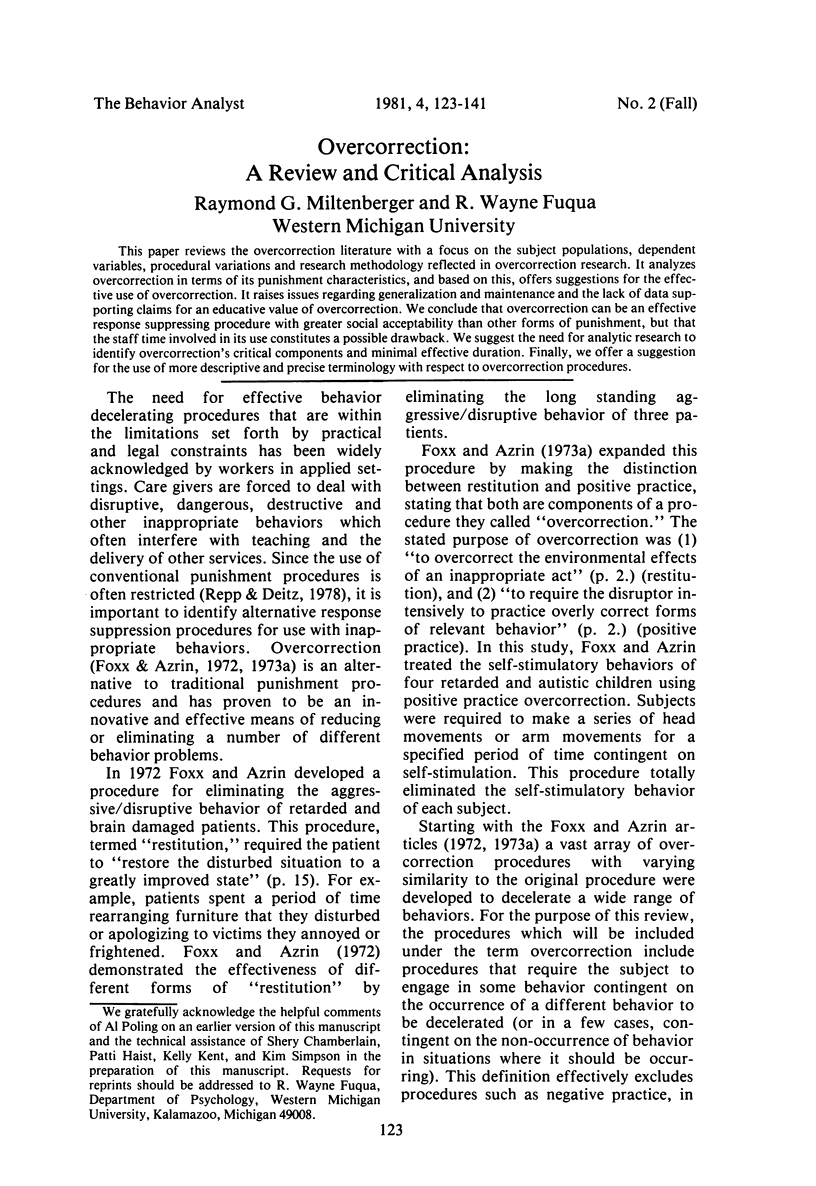
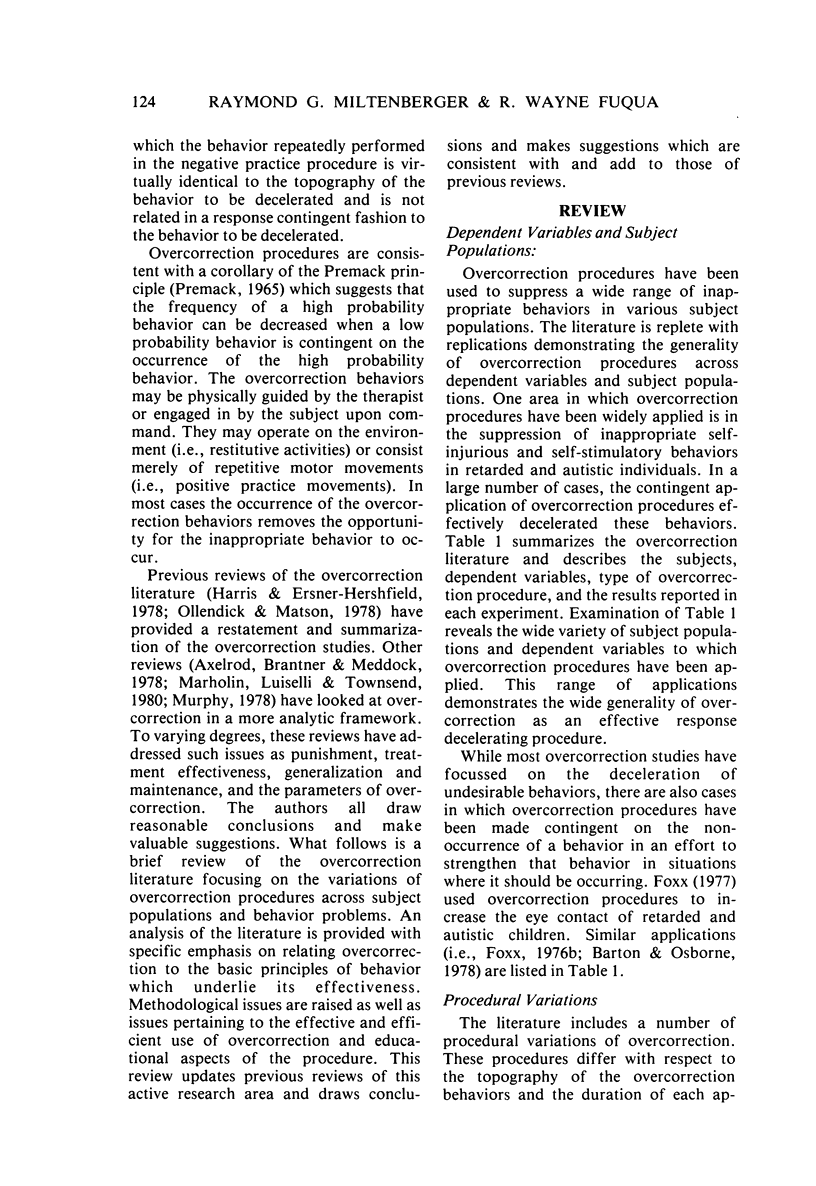
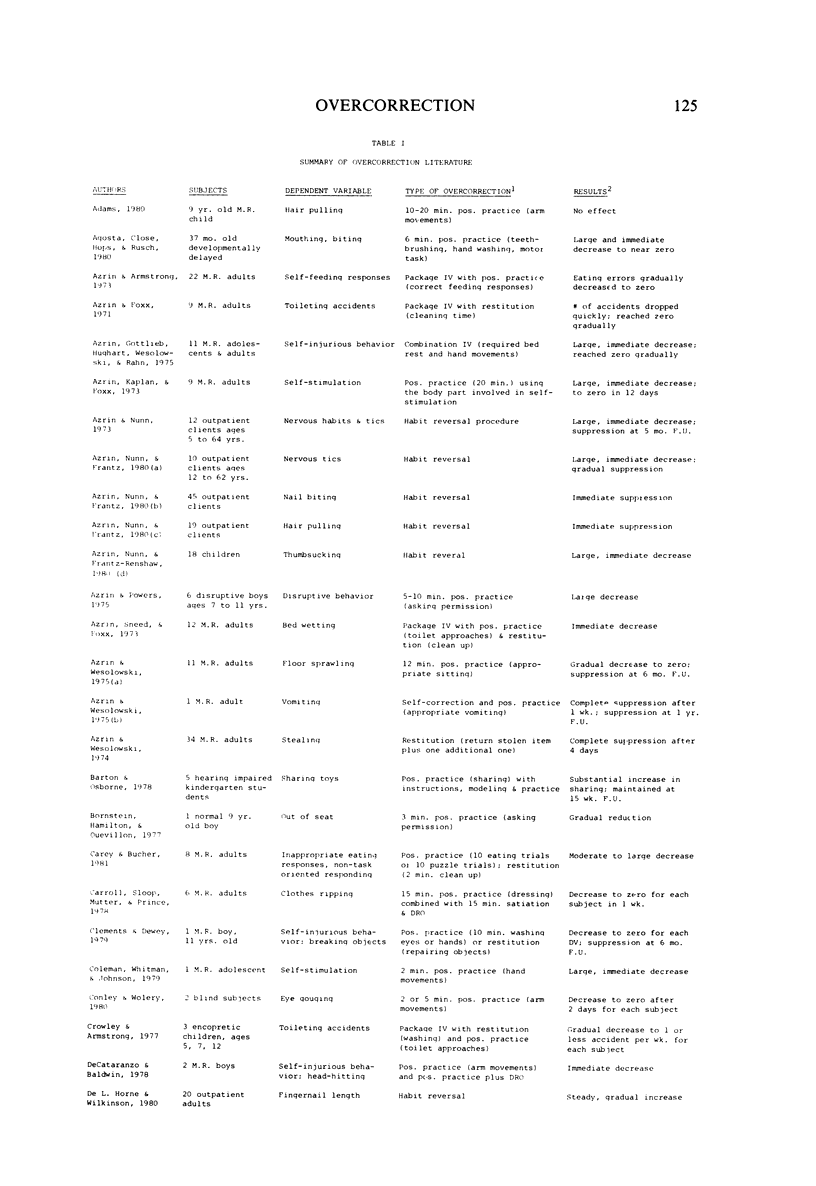
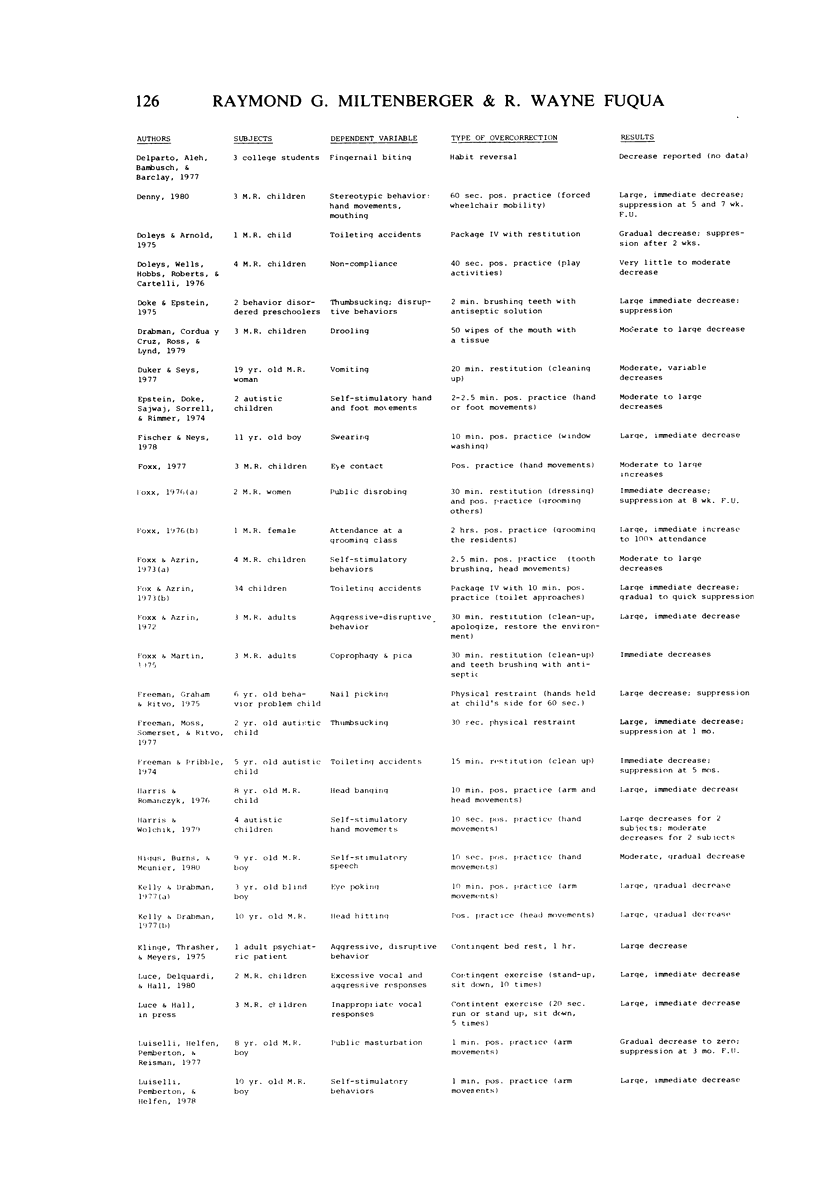
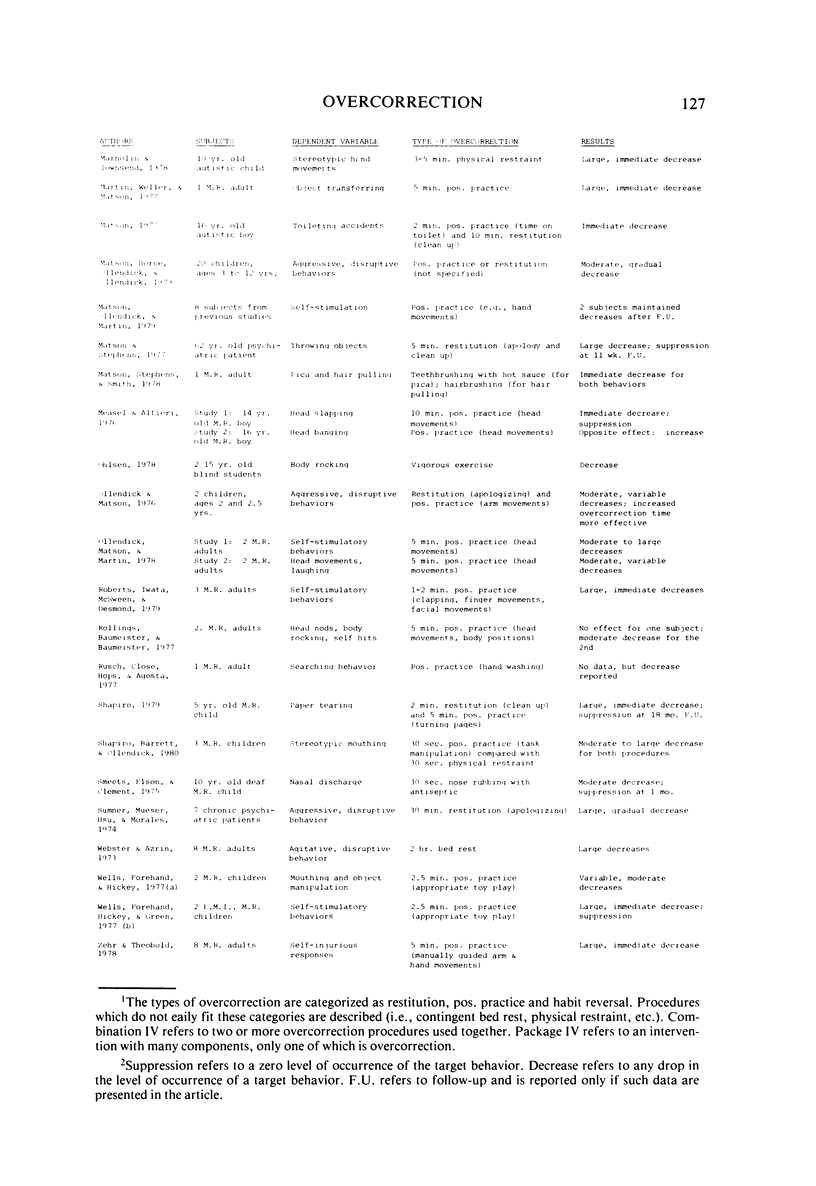
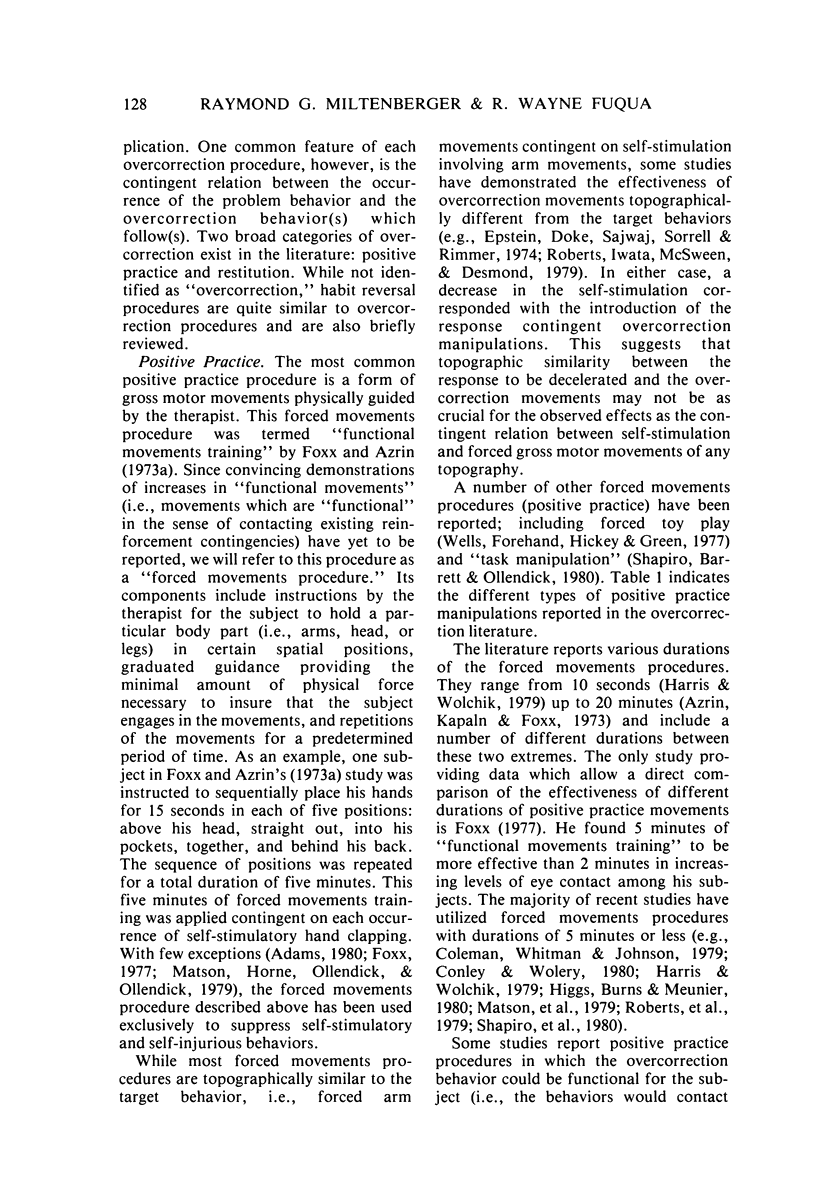
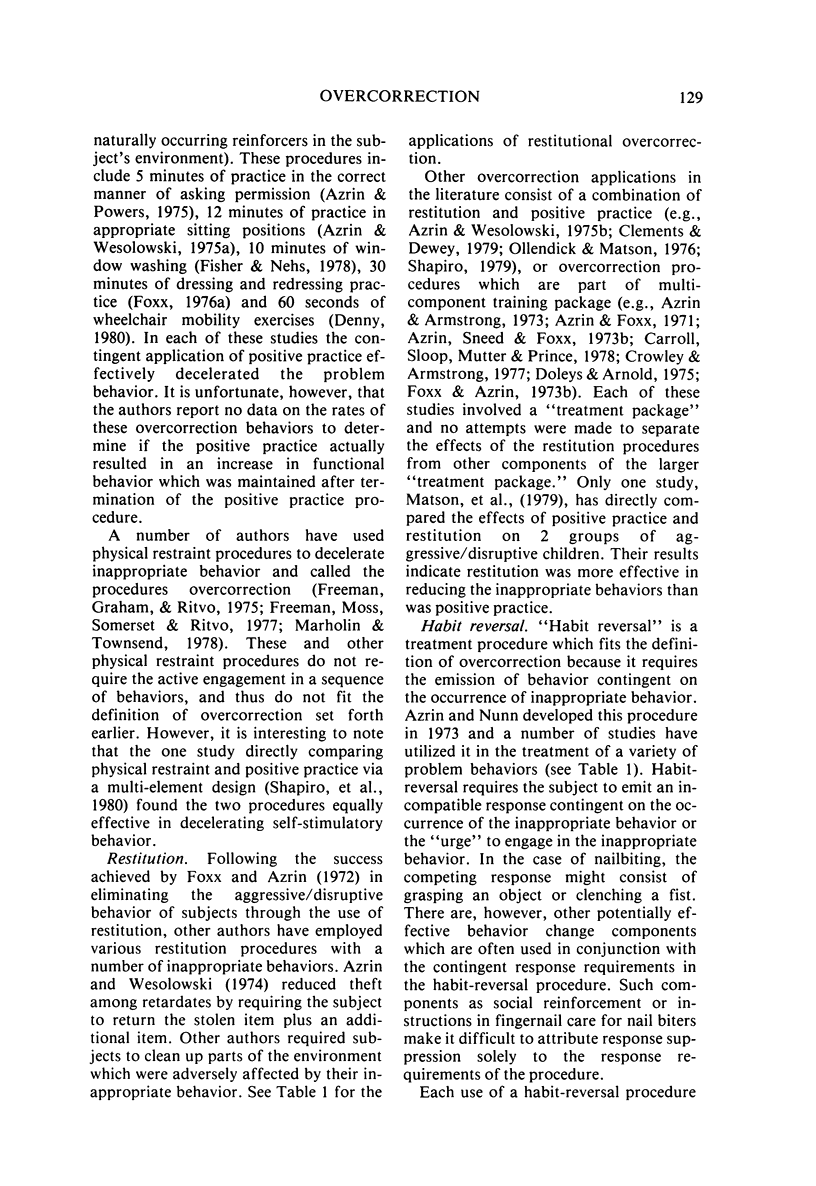
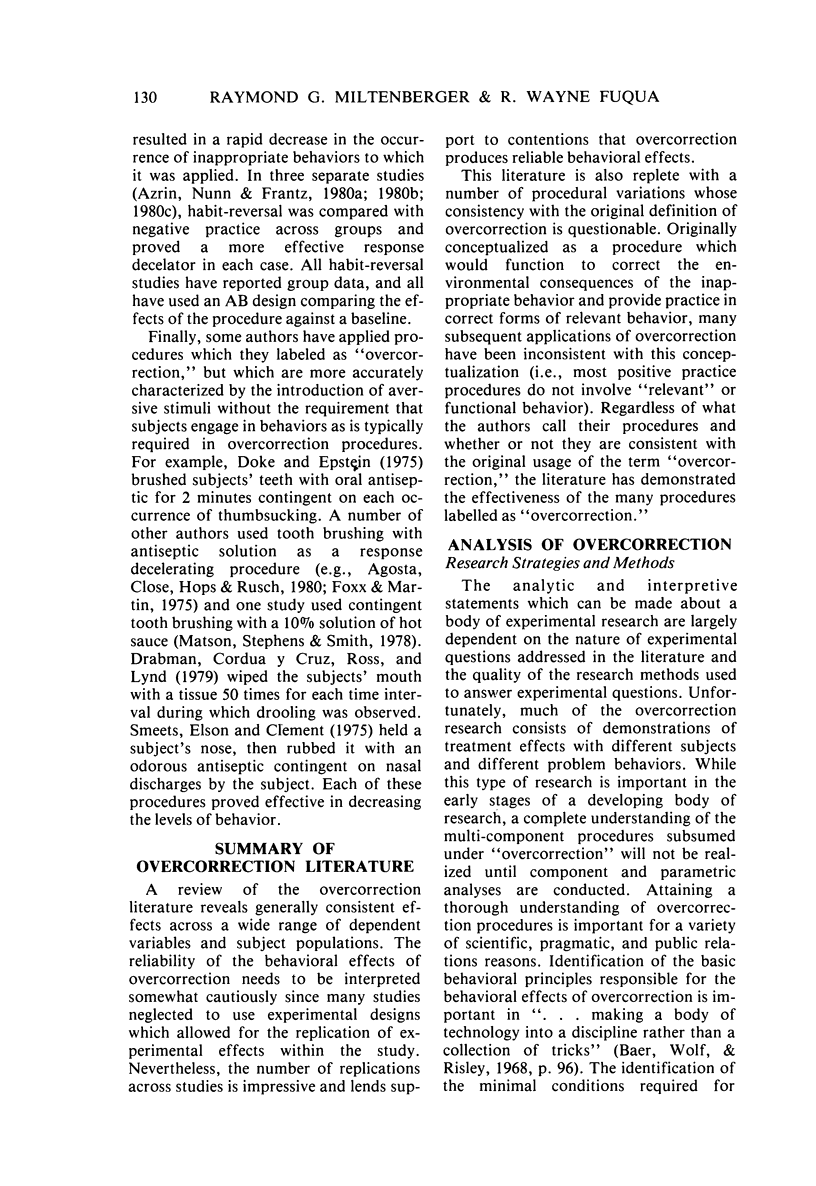
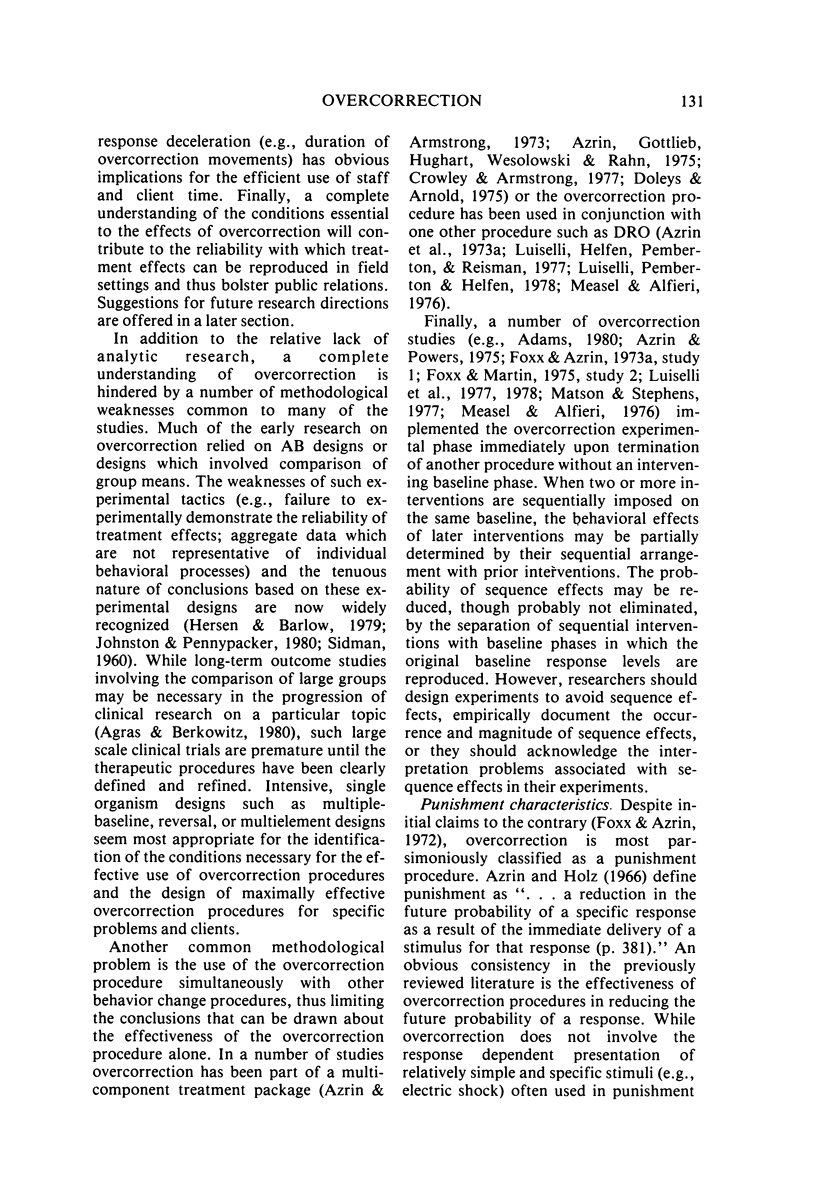
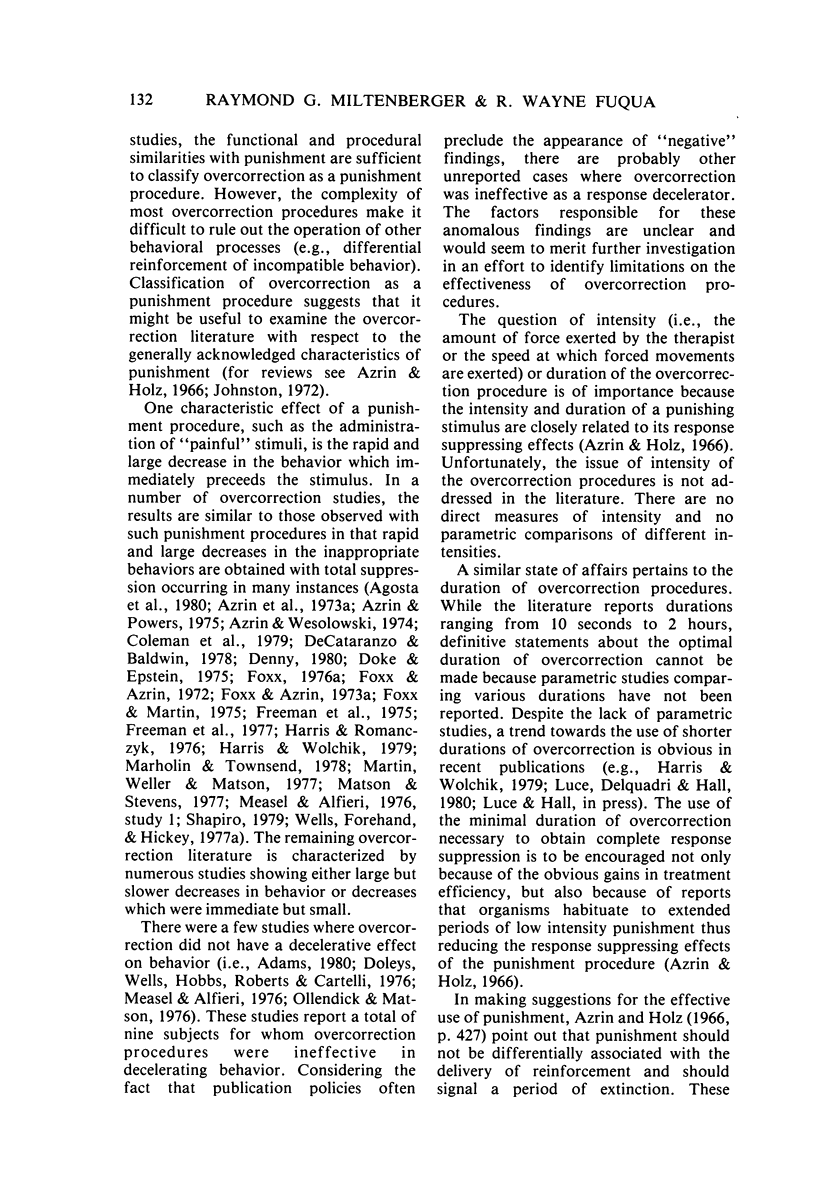
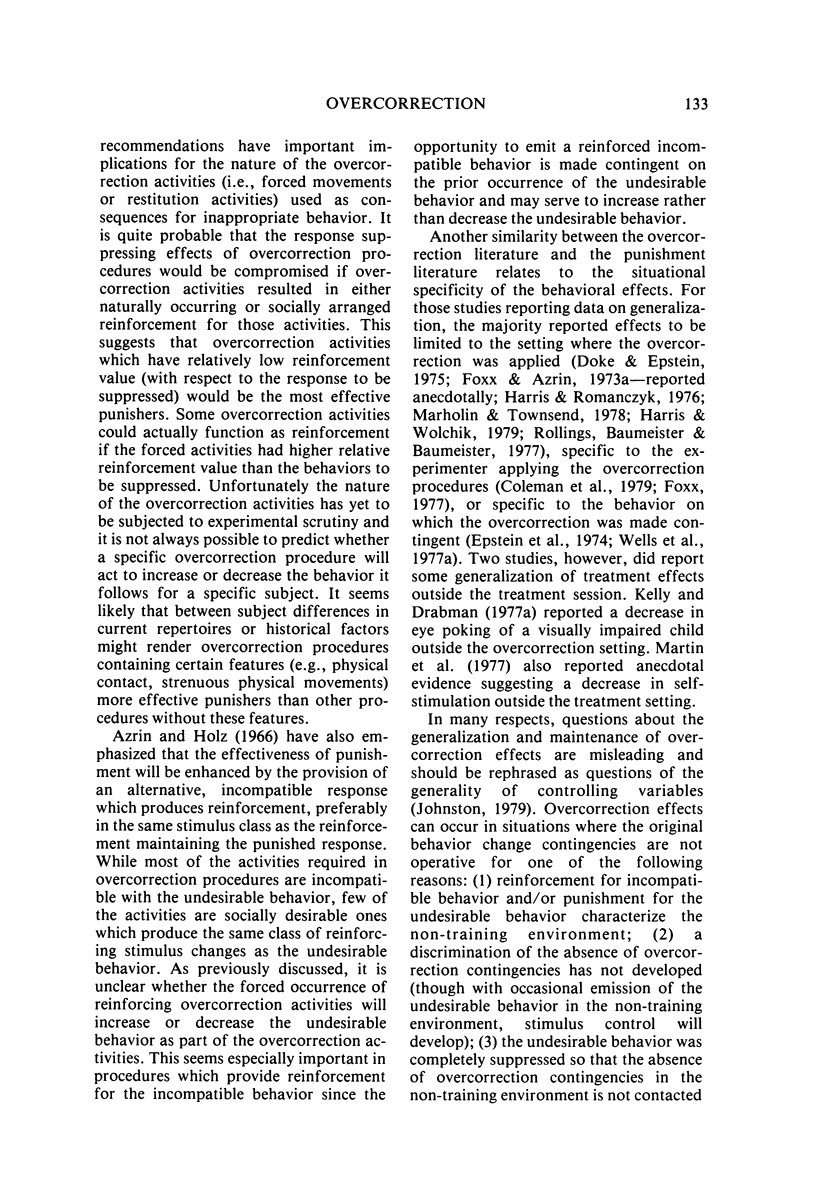
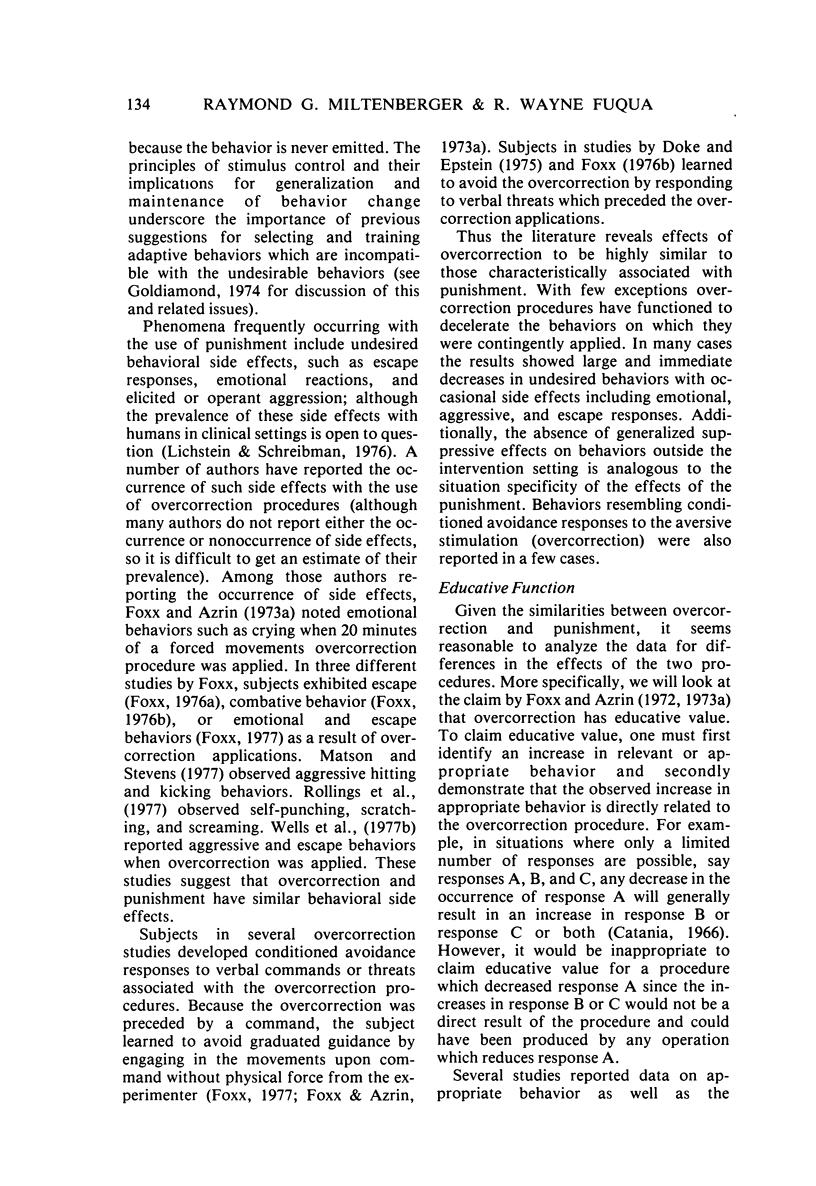
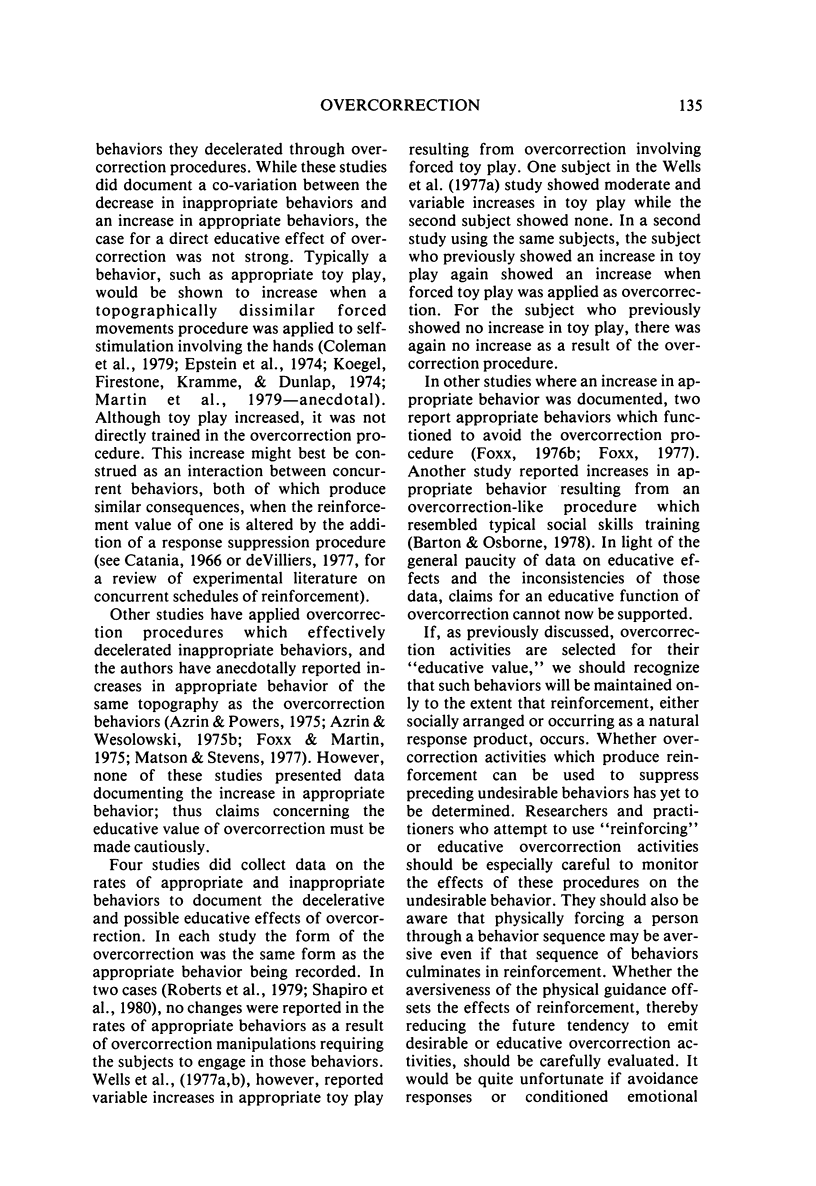
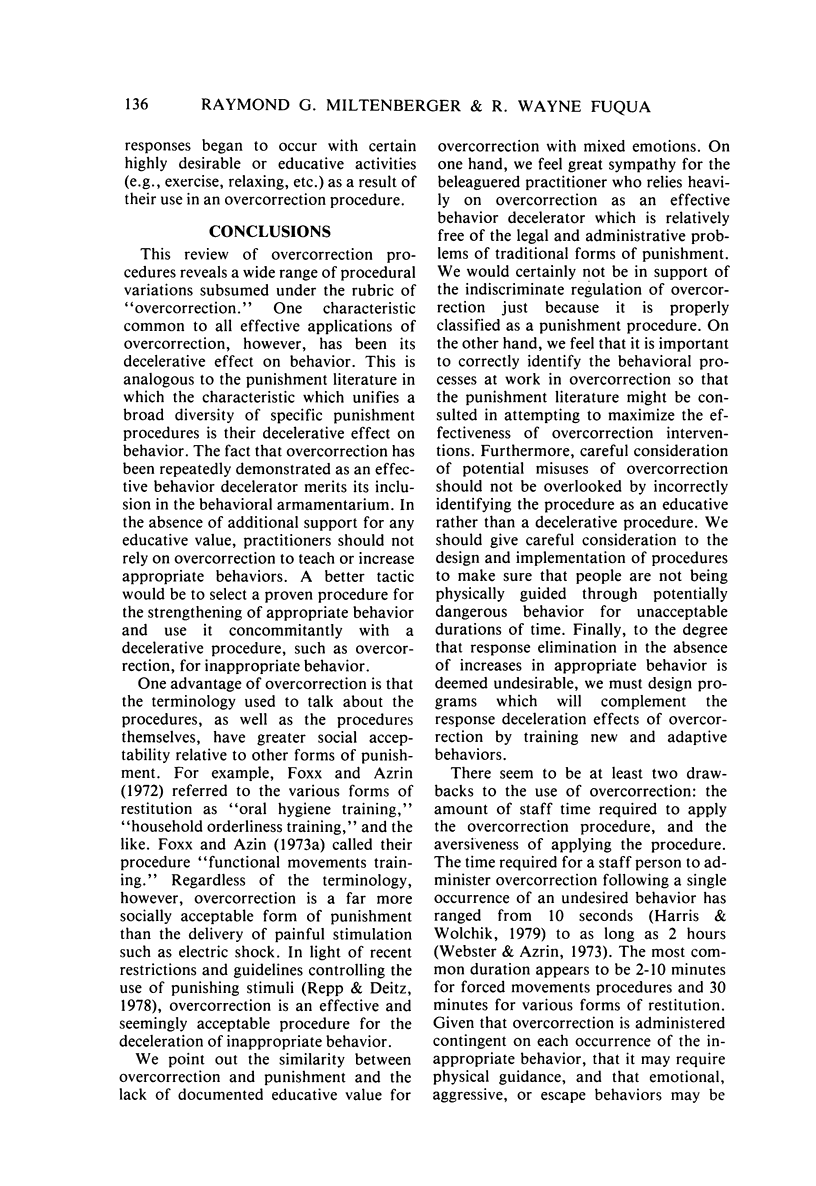
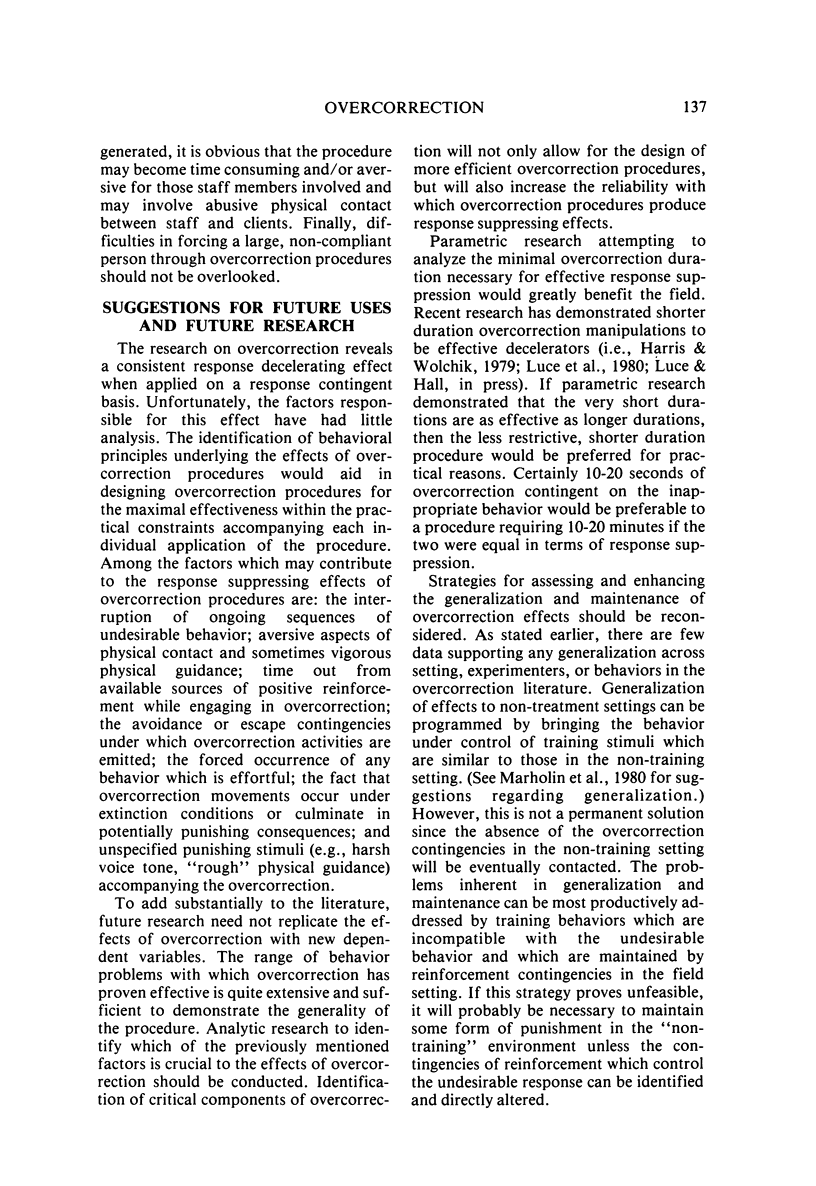
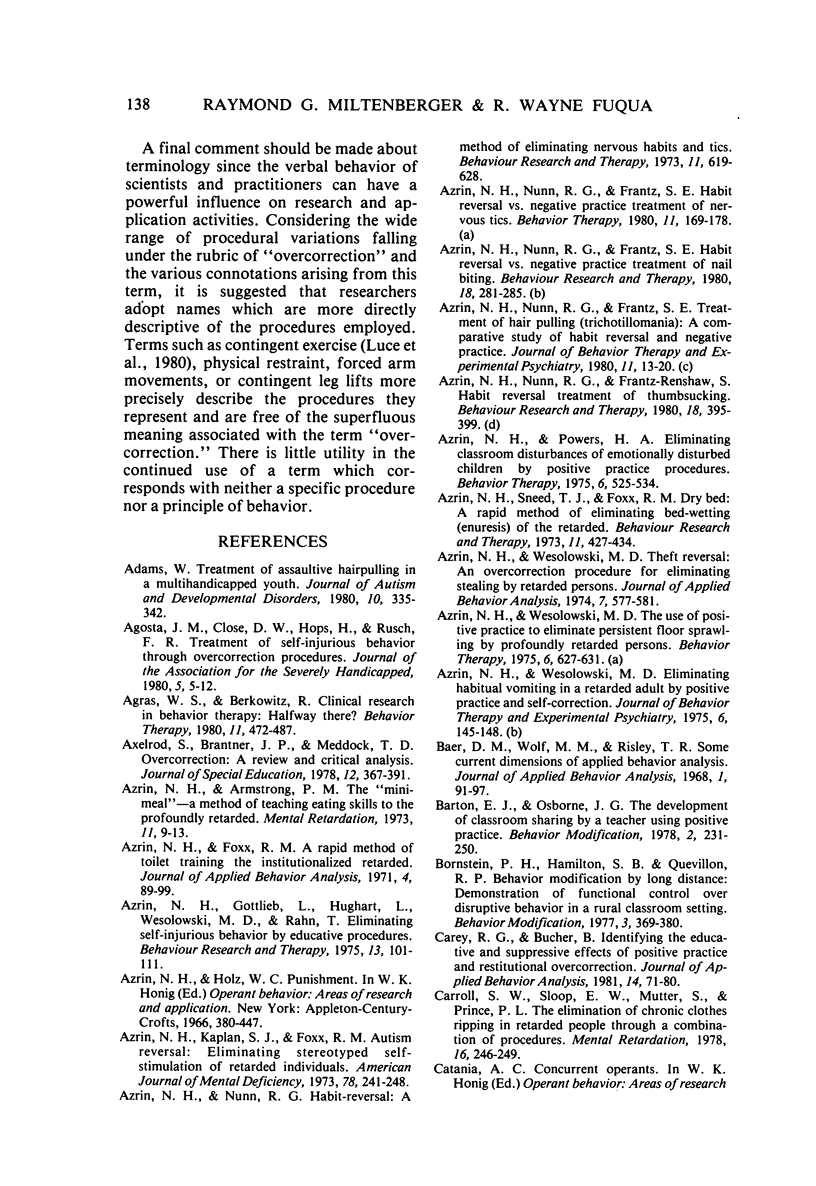
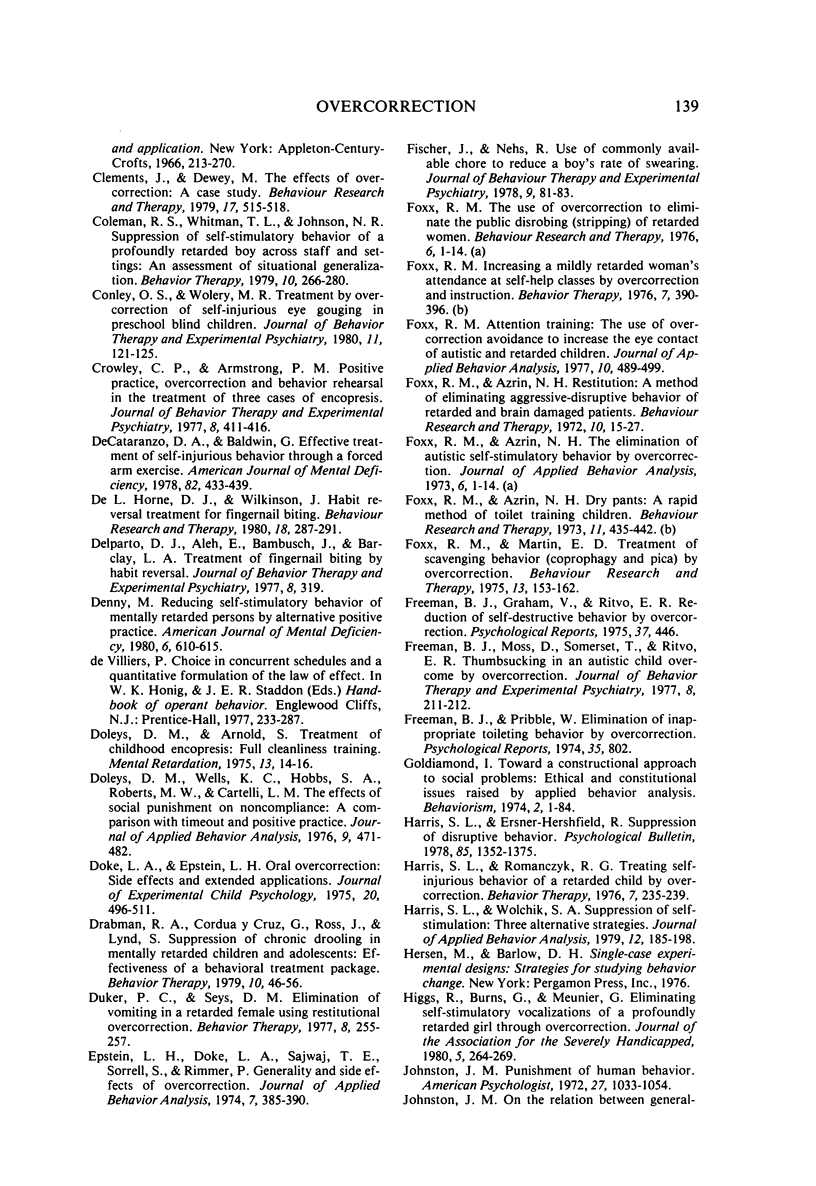
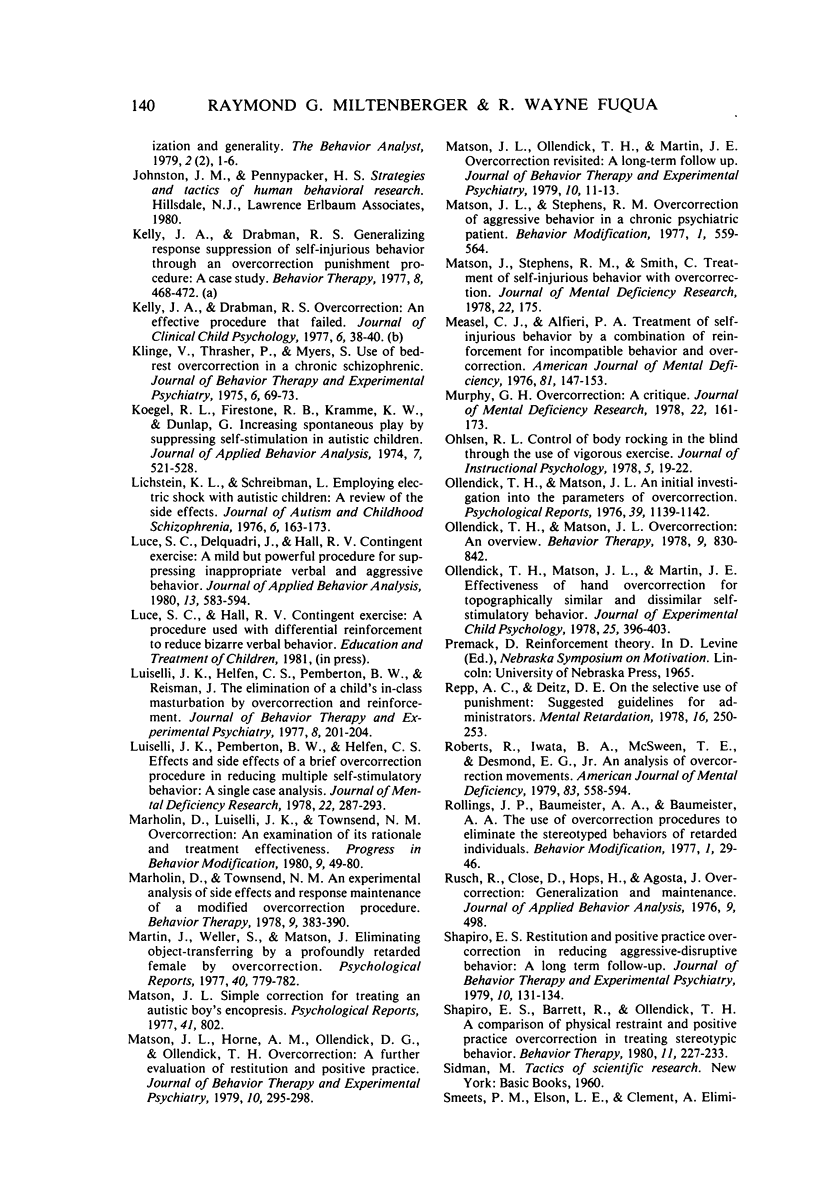
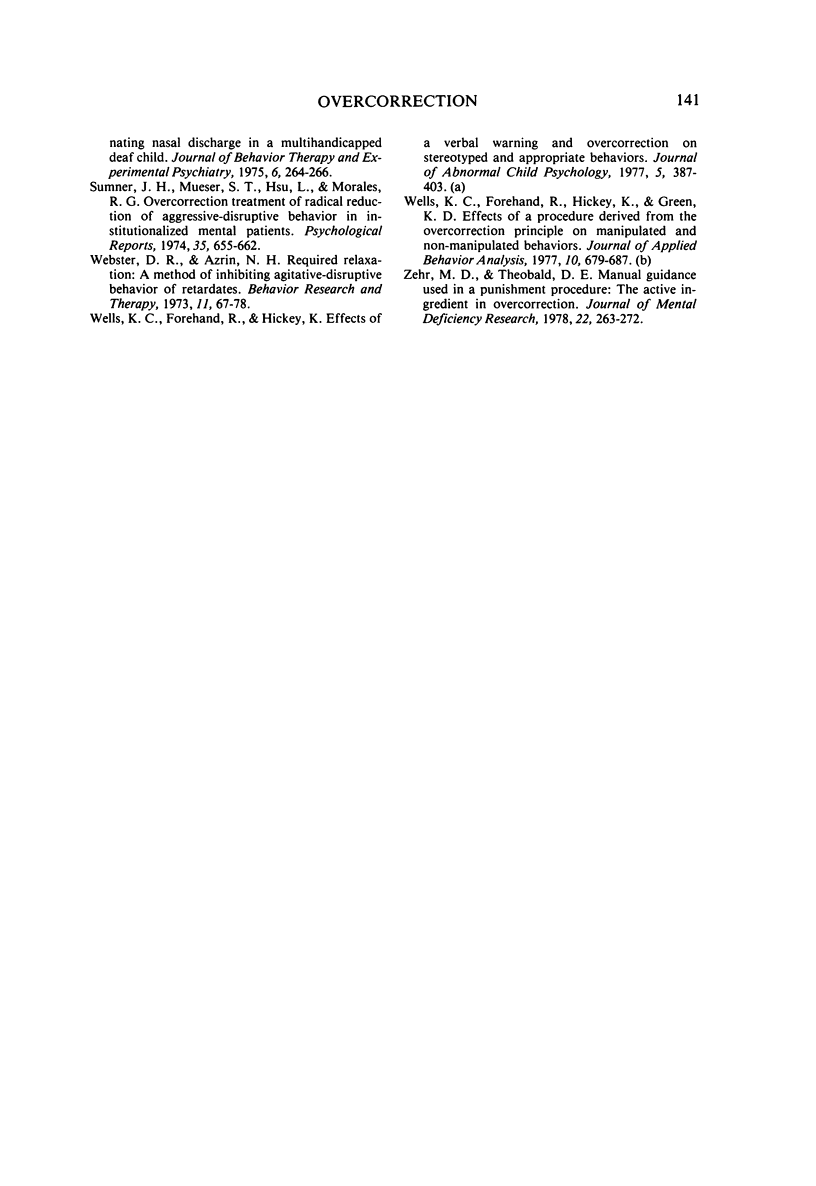
Selected References
These references are in PubMed. This may not be the complete list of references from this article.
- Adams W. Treatment of assaultive hair pulling in a multihandicapped youth. J Autism Dev Disord. 1980 Sep;10(3):335–342. doi: 10.1007/BF02408292. [DOI] [PubMed] [Google Scholar]
- Azrin N. H., Armstrong P. M. The "Mini-Meal". A method for teaching eating skills to the profoundly retarded. Ment Retard. 1973 Feb;11(1):9–13. [PubMed] [Google Scholar]
- Azrin N. H., Foxx R. M. A rapid method of toilet training the institutionalized retarded. J Appl Behav Anal. 1971 Summer;4(2):89–99. doi: 10.1901/jaba.1971.4-89. [DOI] [PMC free article] [PubMed] [Google Scholar]
- Azrin N. H., Gottlieb L., Hughart L., Wesolowski M. D., Rahn T. Eliminating self-injurious behavior by educative procedures. Behav Res Ther. 1975 Jun;13(2-3):101–111. doi: 10.1016/0005-7967(75)90004-2. [DOI] [PubMed] [Google Scholar]
- Azrin N. H., Kaplan S. J., Foxx R. M. Autism reversal: eliminating stereotyped self-stimulation of retarded individuals. Am J Ment Defic. 1973 Nov;78(3):241–248. [PubMed] [Google Scholar]
- Azrin N. H., Nunn R. G., Frantz-Renshaw S. Habit reversal treatment of thumbsucking. Behav Res Ther. 1980;18(5):395–399. doi: 10.1016/0005-7967(80)90004-2. [DOI] [PubMed] [Google Scholar]
- Azrin N. H., Nunn R. G., Frantz S. E. Habit reversal vs. negative practice treatment of nailbiting. Behav Res Ther. 1980;18(4):281–285. doi: 10.1016/0005-7967(80)90086-8. [DOI] [PubMed] [Google Scholar]
- Azrin N. H., Nunn R. G. Habit-reversal: a method of eliminating nervous habits and tics. Behav Res Ther. 1973 Nov;11(4):619–628. doi: 10.1016/0005-7967(73)90119-8. [DOI] [PubMed] [Google Scholar]
- Azrin N. H., Sneed T. J., Foxx R. M. Dry bed: a rapid method of eliminating bedwetting (enuresis) of the retarded. Behav Res Ther. 1973 Nov;11(4):427–434. doi: 10.1016/0005-7967(73)90101-0. [DOI] [PubMed] [Google Scholar]
- Azrin N. H., Wesolowski M. D. Theft reversal: an overcorrection procedure for eliminating stealing by retarded persons. J Appl Behav Anal. 1974 Winter;7(4):577–581. doi: 10.1901/jaba.1974.7-577. [DOI] [PMC free article] [PubMed] [Google Scholar]
- Baer D. M., Wolf M. M., Risley T. R. Some current dimensions of applied behavior analysis. J Appl Behav Anal. 1968 Spring;1(1):91–97. doi: 10.1901/jaba.1968.1-91. [DOI] [PMC free article] [PubMed] [Google Scholar]
- Carey R. G., Bucher B. Identifying the educative and suppressive effects of positive practice and restitutional overcorrection. J Appl Behav Anal. 1981 Spring;14(1):71–80. doi: 10.1901/jaba.1981.14-71. [DOI] [PMC free article] [PubMed] [Google Scholar]
- Carroll S. W., Sloop E. W., Mutter S., Prince P. L. The elimination of chronic clothes ripping in retarded people through a combination of procedures. Ment Retard. 1978 Jun;16(3):246–249. [PubMed] [Google Scholar]
- DeCatanzaro D. A., Baldwin G. Effective treatment of self-injurious behavior through a forced arm exercise. Am J Ment Defic. 1978 Mar;82(5):433–439. [PubMed] [Google Scholar]
- Denny M. Reducing self-stimulatory behavior of mentally retarded persons by alternative positive practice. Am J Ment Defic. 1980 May;84(6):610–615. [PubMed] [Google Scholar]
- Doke L. A., Epstein L. H. Oral overcorrection: side effects and extended applications. J Exp Child Psychol. 1975 Dec;20(3):496–511. doi: 10.1016/0022-0965(75)90122-8. [DOI] [PubMed] [Google Scholar]
- Doleys D. M., Arnold S. Treatment of childhood encopresis: full cleanliness training. Ment Retard. 1975 Dec;13(6):14–16. [PubMed] [Google Scholar]
- Doleys D. M., Wells K. C., Hobbs S. A., Roberts M. W., Cartelli L. M. The effects of social punishment on noncompliance: a comparison with timeout and positive practice. J Appl Behav Anal. 1976 WINTER;9(4):471–482. doi: 10.1901/jaba.1976.9-471. [DOI] [PMC free article] [PubMed] [Google Scholar]
- Epstein L. H., Doke L. A., Sajwaj T. E., Sorrell S., Rimmer B. Generality and side effects of overcorrection. J Appl Behav Anal. 1974 Fall;7(3):385–390. doi: 10.1901/jaba.1974.7-385. [DOI] [PMC free article] [PubMed] [Google Scholar]
- Foxx R. M. Attention training: the use of overcorrection avoidance to increase the eye contact of autistic and retarded children. J Appl Behav Anal. 1977 Fall;10(3):489–499. doi: 10.1901/jaba.1977.10-489. [DOI] [PMC free article] [PubMed] [Google Scholar]
- Foxx R. M., Azrin N. H. Dry pants: a rapid method of toilet training children. Behav Res Ther. 1973 Nov;11(4):435–442. doi: 10.1016/0005-7967(73)90102-2. [DOI] [PubMed] [Google Scholar]
- Foxx R. M., Azrin N. H. Restitution: a method of eliminating aggressive-disruptive behavior of retarded and brain damaged patients. Behav Res Ther. 1972 Feb;10(1):15–27. doi: 10.1016/0005-7967(72)90003-4. [DOI] [PubMed] [Google Scholar]
- Foxx R. M., Azrin N. H. The elimination of autistic self-stimulatory behavior by overcorrection. J Appl Behav Anal. 1973 Spring;6(1):1–14. doi: 10.1901/jaba.1973.6-1. [DOI] [PMC free article] [PubMed] [Google Scholar]
- Foxx R. M., Martin E. D. Treatment of scavenging behavior (coprophagy and pica) by overcorrection. Behav Res Ther. 1975 Jun;13(2-3):153–162. doi: 10.1016/0005-7967(75)90009-1. [DOI] [PubMed] [Google Scholar]
- Freeman B. J., Graham V., Ritvo E. R. Reduction of self-destructive behavior by overcorrection. Psychol Rep. 1975 Oct;37(2):446–446. doi: 10.2466/pr0.1975.37.2.446. [DOI] [PubMed] [Google Scholar]
- Goldiamond Israel. Toward a constructional approach to social problems: ethical and constitutional issues raised by applied behavior analysis. Behaviorism. 1974 Spring;2(1):1–84. [PubMed] [Google Scholar]
- Harris S. L., Ersner-Hershfield R. Behavioral suppression of seriously disruptive behavior in psychotic and retarded patients: a review of punishment and its alternatives. Psychol Bull. 1978 Nov;85(6):1352–1375. [PubMed] [Google Scholar]
- Harris S. L., Wolchik S. A. Suppression of self-stimulation: three alternative strategies. J Appl Behav Anal. 1979 Summer;12(2):185–198. doi: 10.1901/jaba.1979.12-185. [DOI] [PMC free article] [PubMed] [Google Scholar]
- Horne D. J., Wilkinson J. Habit reversal treatment for fingernail biting. Behav Res Ther. 1980;18(4):287–291. doi: 10.1016/0005-7967(80)90087-x. [DOI] [PubMed] [Google Scholar]
- Johnston J. M. On the relation between generalization and generality. Behav Anal. 1979 Fall;2(2):1–6. doi: 10.1007/BF03391833. [DOI] [PMC free article] [PubMed] [Google Scholar]
- Johnston J. M. Punishment of human behavior. Am Psychol. 1972 Nov;27(11):1033–1054. doi: 10.1037/h0033887. [DOI] [PubMed] [Google Scholar]
- Koegel R. L., Firestone P. B., Kramme K. W., Dunlap G. Increasing spontaneous play by suppressing self-stimulation in autistic children. J Appl Behav Anal. 1974 Winter;7(4):521–528. doi: 10.1901/jaba.1974.7-521. [DOI] [PMC free article] [PubMed] [Google Scholar]
- Lichstein K. L., Schreibman L. Employing electric shock with autistic children. A review of the side effects. J Autism Child Schizophr. 1976 Jun;6(2):163–173. doi: 10.1007/BF01538060. [DOI] [PubMed] [Google Scholar]
- Luce S. C., Delquadri J., Hall R. V. Contingent exercise: a mild but powerful procedure for suppressing inappropriate verbal and aggressive behavior. J Appl Behav Anal. 1980 Winter;13(4):583–594. doi: 10.1901/jaba.1980.13-583. [DOI] [PMC free article] [PubMed] [Google Scholar]
- Luiselli J. K., Pemberton B. W., Helfen C. S. Effects and side-effects of a brief overcorrection procedure in reducing multiple self-stimulatory behaviour: a single case analysis. J Ment Defic Res. 1978 Dec;22(4):287–293. doi: 10.1111/j.1365-2788.1978.tb00987.x. [DOI] [PubMed] [Google Scholar]
- Martin J., Weller S., Matson J. Eliminating object-transferring by a profoundly retarded female by overcorrection. Psychol Rep. 1977 Jun;40(3 Pt 2):779–782. doi: 10.2466/pr0.1977.40.3.779. [DOI] [PubMed] [Google Scholar]
- Matson J. L. Simple correction for treating an autistic boy's encopresis. Psychol Rep. 1977 Dec;41(3 Pt 1):802–802. doi: 10.2466/pr0.1977.41.3.802. [DOI] [PubMed] [Google Scholar]
- Matson J. L., Stephens R. M., Smith C. Treatment of self-injurious behaviour with overcorrection. J Ment Defic Res. 1978 Sep;22(3):175–178. doi: 10.1111/j.1365-2788.1978.tb00974.x. [DOI] [PubMed] [Google Scholar]
- Measel C. J., Alfieri P. A. Treatment of self-injurious behavior by a combination of reinforcement for incompatible behavior and overcorrection. Am J Ment Defic. 1976 Sep;81(2):147–153. [PubMed] [Google Scholar]
- Morton R. E., DeLuca R. F., Reisman T. N., Rogers A. I. Gastrocolic fistula secondary to benign gastric ulcer not operated upon: case report and review of literature. South Med J. 1977 Feb;70(2):201–204. doi: 10.1097/00007611-197702000-00029. [DOI] [PubMed] [Google Scholar]
- Murphy G. H. Overcorrection: a critique. J Ment Defic Res. 1978 Sep;22(3):161–173. doi: 10.1111/j.1365-2788.1978.tb00973.x. [DOI] [PubMed] [Google Scholar]
- Ollendick T. H., Matson J. L. An initial investigation into the parameters of overcorrection. Psychol Rep. 1976 Dec;39(3 Pt 2):1139–1142. doi: 10.2466/pr0.1976.39.3f.1139. [DOI] [PubMed] [Google Scholar]
- Ollendick T. H., Matson J. L. Effectiveness of hand overcorrection for topographically similar and dissimilar self-stimulatory behavior. J Exp Child Psychol. 1978 Jun;25(3):396–403. doi: 10.1016/0022-0965(78)90063-2. [DOI] [PubMed] [Google Scholar]
- doi: 10.1901/jaba.1976.9-498. [DOI] [PMC free article] [Google Scholar]
- Repp A. C., Deitz D. E. On the selective use of punishment--suggested guidelines for administrators. Ment Retard. 1978 Jun;16(3):250–254. [PubMed] [Google Scholar]
- Roberts P., Iwata B. A., McSween T. E., Desmond E. F., Jr An analysis of overcorrection movements. Am J Ment Defic. 1979 May;83(6):588–594. [PubMed] [Google Scholar]
- Sumner J. H., Mueser S. T., Hsu L., Morales R. G. Overcorrection treatment for radical reduction of aggressive-disruptive behavior in institutionalized mental patients. Psychol Rep. 1974 Aug;35(1 Pt 2):655–662. doi: 10.2466/pr0.1974.35.1.655. [DOI] [PubMed] [Google Scholar]
- The effects of overcorrection: a case study. Behav Res Ther. 1979;17(5):515–518. doi: 10.1016/0005-7967(79)90068-8. [DOI] [PubMed] [Google Scholar]
- Webster D. R., Azrin N. H. Required relaxation: a method of inhibiting agitative-disruptive behavior of retardates. Behav Res Ther. 1973 Feb;11(1):67–78. doi: 10.1016/0005-7967(73)90070-3. [DOI] [PubMed] [Google Scholar]
- Wells K. C., Forehand R., Hickey K. Effects of a verbal warning and overcorrection on stereotyped and appropriate behaviors. J Abnorm Child Psychol. 1977 Dec;5(4):387–403. doi: 10.1007/BF00915087. [DOI] [PubMed] [Google Scholar]
- Wells K. C., Forehand R., Hickey K., Green K. D. Effects of a procedure derived from the overcorrection principle on manipulated and nonmanipulated behaviors. J Appl Behav Anal. 1977 Winter;10(4):679–687. doi: 10.1901/jaba.1977.10-679. [DOI] [PMC free article] [PubMed] [Google Scholar]
- Zehr M. D., Theobald D. E. Manual guidance used in a punishment procedure: the active ingredient in overcorrection. J Ment Defic Res. 1978 Dec;22(4):263–272. doi: 10.1111/j.1365-2788.1978.tb00984.x. [DOI] [PubMed] [Google Scholar]


